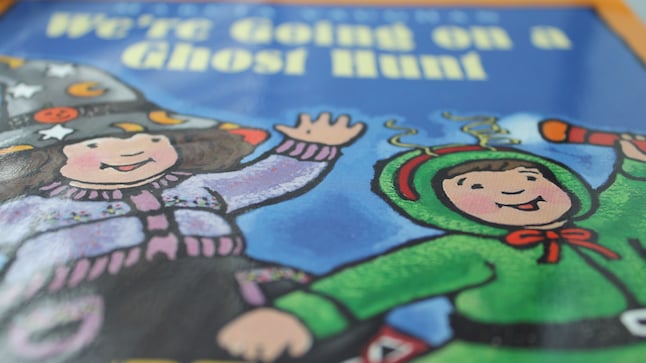Series: Book Ideas
4 Books That Can Expand Children’s Spatial Sense
by Cody Meirick This is an Article - for grade levels Pre-K, Kindergarten, 1st Grade, 2nd Grade, 3rd Grade
Tagged Mapping, Seasonal, Books, Eric Carle, Tana Hoban, Joan Sweeney, Marcia Vaughan, The Secret Birthday Message, We're Going on a Ghost Hunt, Me on the Map, Over Under and Through

A great way to have children explore spatial relationships is to read books that call for children to think and talk about where objects and people are in relation to something else. Young children show their understanding of these relationships by acting out the stories and moving their own bodies through space. They also use language to describe positions and locations and can make their own maps.
Here are a few of our favorite children’s books that can be great opportunities to start an activity or conversation.
-
We’re Going on a Ghost Hunt by Marcia Vaughan
This Halloween favorite is a variation of the old “We’re going on a bear hunt” story. Children set off on a ghost hunt, which takes them through all sorts of scary places like an ooky spooky swamp and a creepy cave. It’s a fun read, but it’s even more fun to act out the ghost hunt and the helter skelter dash back to the safety of home. Just like the bear hunt tale, children come to obstacles and have to decide whether they go over, under, through or any number of other ways to get to their destination. The more children can immerse themselves with these positional words and act out what they really mean, the better.
-
Over, Under, and Through by Tana Hoban
Another great photographic book by Tana Hoban, this simple yet powerful book lets young children explore those important positional words. Not just those three words, but a host of others words like beside, below, on, and in and many others allow children to hear and examine the many different ways objects can be in relation to others. Pair this with an activity and have children discuss! For one example, watch our Focus on the Lesson video involving an obstacle course in a preschool classroom. Here are related lesson plan ideas from website MathatHome.org.
-
Me on the Map by Joan Sweeney
Having fun with spatial and positional words often leads to fun with maps. Me on the Map is a great entry point for discussing what maps are. And it can become the beginning of children’s experiences in making their own maps!
-
The Secret Birthday Message by Eric Carle
This classic uses shapes and spatial relationships to tell the story of Tim and his quest to find his birthday surprise. The treasure hunt that ensues allows for all kinds of opportunities to work with mapping to represent the world (and a birthday expedition) in the form of a map. Here are more related ideas from the Eric Carle website.
-
Common Core Alignment
Geometry Read More
-
Foundational Math Topics
Read more about Spatial Relationships